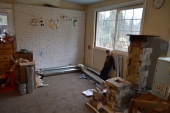posted 11 years ago
Fiber-rich finishes will generally hold up better to weather than raw cob. If the weather is bad and you don't have long enough eaves, sometimes a lime plaster will do it. (sometimes you need something like a porch roof or awning halfway down the wall, if it's a tall gable-end wall.) Graeme North from NZ has some good white papers on moisture detailing for maritime climates.
Never use cement-based stuccos or plasters on a cob wall, they will trap moisture in the cob (usually at the base of the wall) and can result in collapse of otherwise sound walls.
In some parts of rural England and Brittainy, it's not unusual to see the weather-side plastered and the other sides left unfinished, or re-plastered less often. I met a fellow from Brittany once who was on his way to Cob Cottage to learn earthen building techniques because his grandparents had an older section of their house/barn that hadn't been re-plastered in 80 years, and the family had decided someone ought to go learn how it was done in case it needed doing in another generation or so. So there's nothing structurally wrong with cob by itself, given adequate footings and eaves it will gently weather at a very slow rate.
I've seen cob 'burnished,' built smooth and then worked over with a steel float when it was leather-hard, to work all the straw stubble in. It can be worked over with a smooth stone or glass bottle, and then waxed or oiled if desired. It can be quite beautiful, you get little flattened strands of straw showing like a deckle glitter through the oiled surface, but I'd say plaster is easier.
You can do almost any level of plaster you want, from something really rough (say a screened cob mix, or cob made with graded builders' sand, with some horse dung instead of straw) just to patch and fill any dents. 'Harled' (thrown) plasters. Rough or textured troweling, like faux-old stuff. Smooth-floated plasters are the master-craftsmanship of which a good drywall job is the pale imitation. You don't need to do multiple layers at first; you can do a 'brown coat' and just leave it on there until you decide you want to upgrade.
-Erica W







